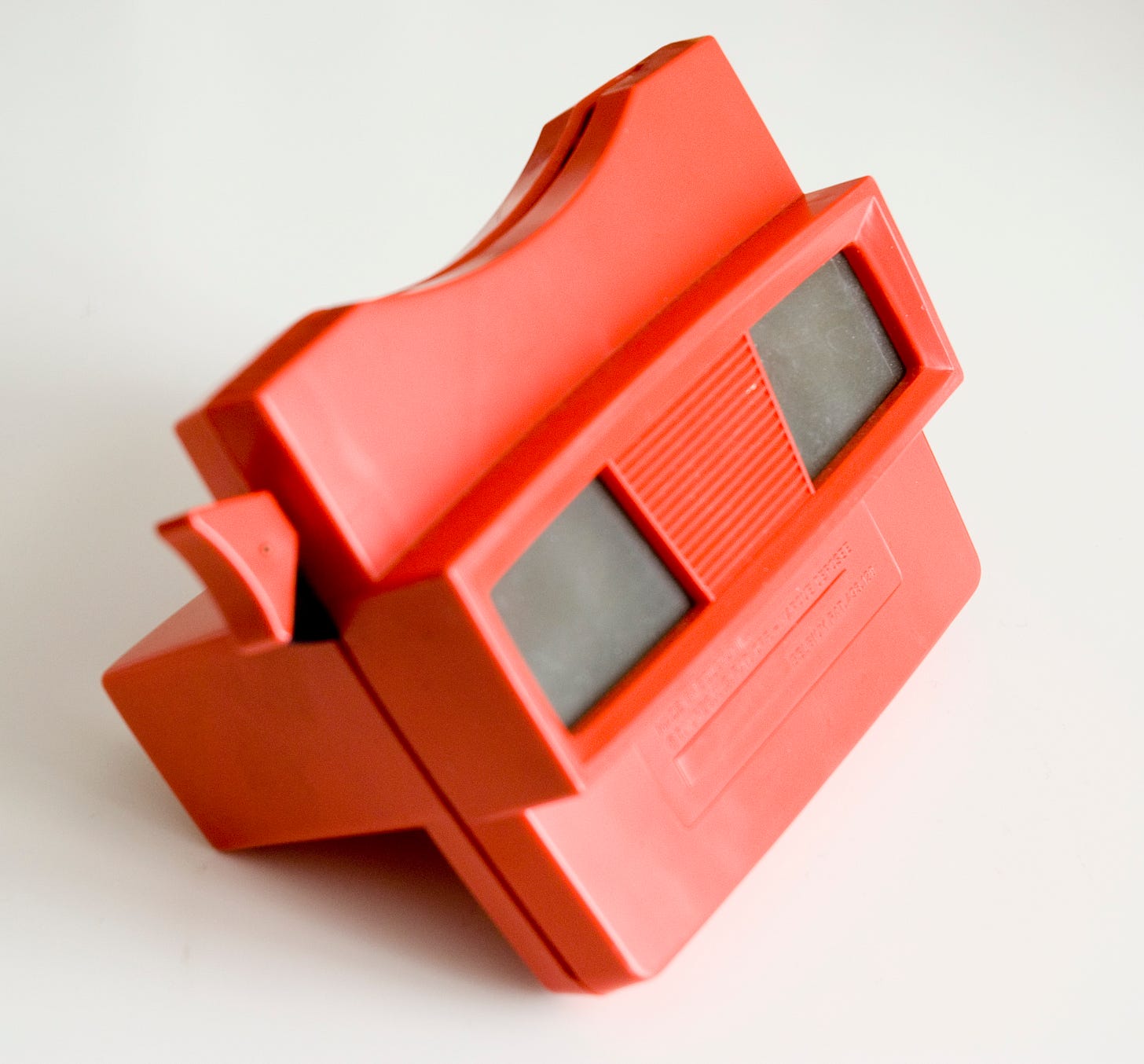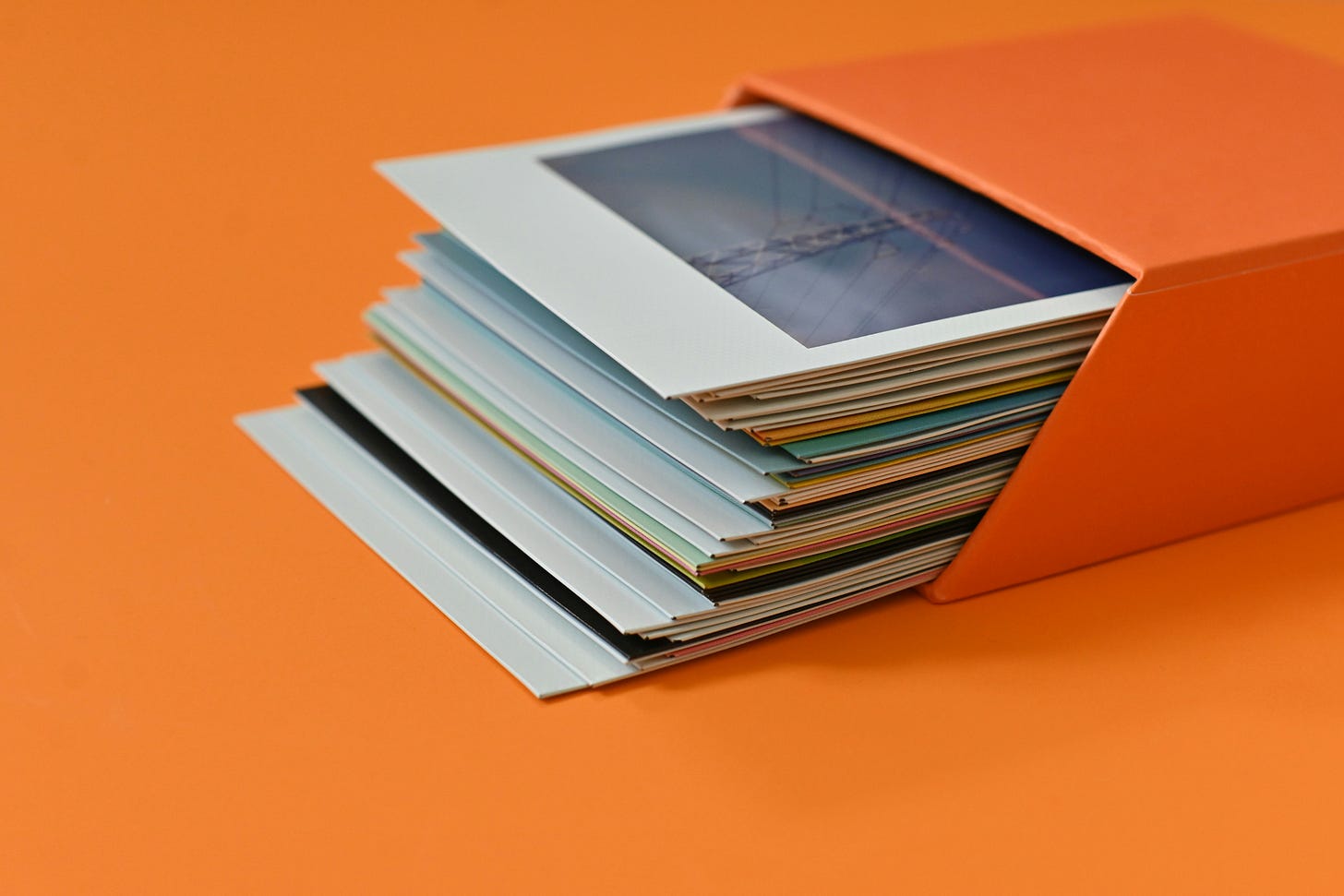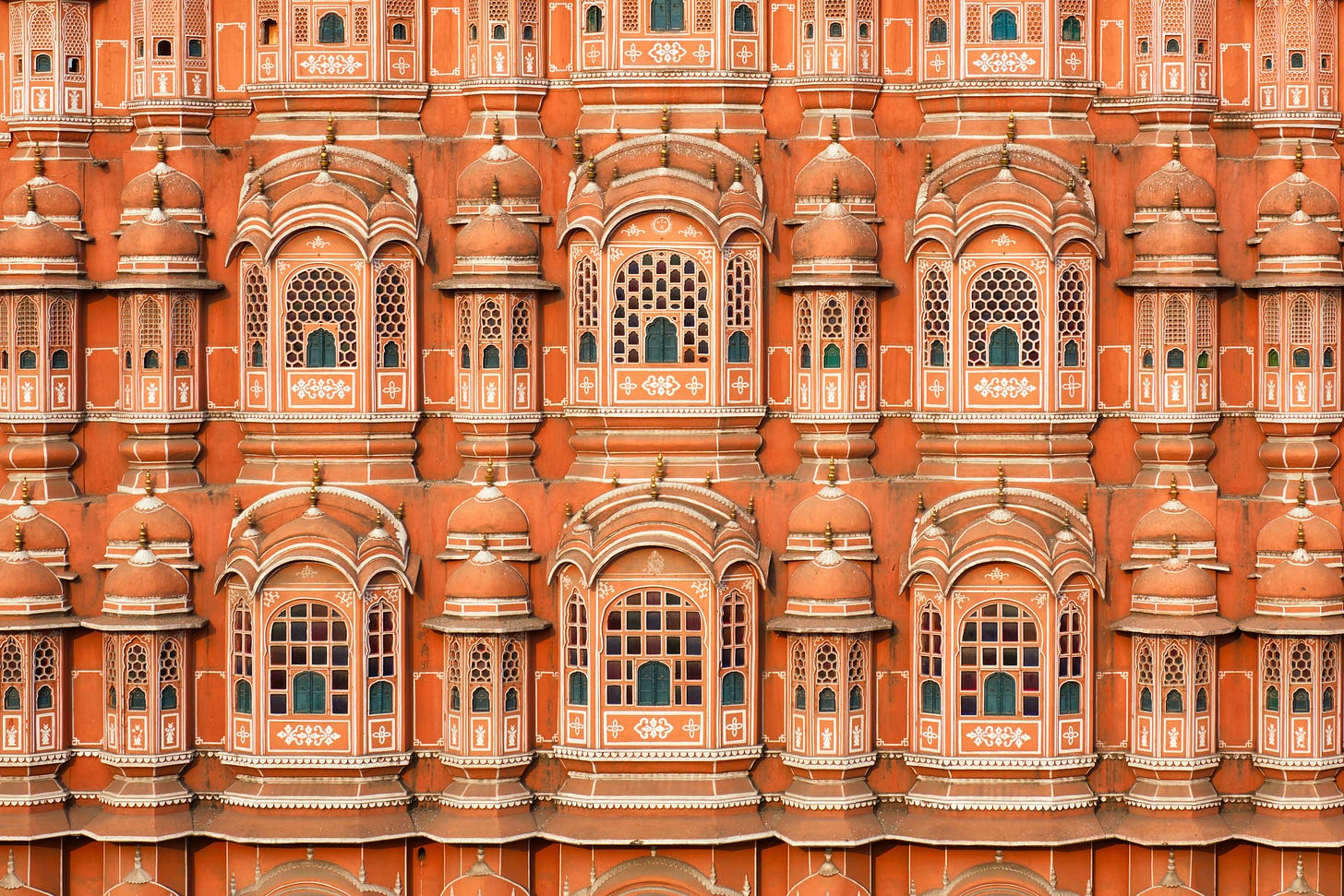Memory & Meaning
How our memories can help us tap into creativity, reconnect with ourselves, and imagine the future
I have a childhood memory that I’ve been toting around for some time now. It’s filed under “life lessons,” and it goes something like this: My childhood bathroom had one sink and a long woodgrain Formica counter with exactly one drawer. There was often a hair dryer left on the counter, and sometimes, after using it, I’d let the plug fall on the floor and saunter out of the bathroom without a care in the world.
Until one day, I walked into the bathroom and stepped on that plug with my bare feet. “Ouch!” I thought to myself, “I probably shouldn’t leave that plug on the floor.” I picked it up, put it back on the counter, and quickly forgot about it. Until I did it again, and yet again, it was me who stepped on the plug. Ouch! My tiny brain finally made the connection: if you don’t pick up the plug, you will step on it, and it will hurt. Pick it up!
It was not too different from the classic tale of burning your hand on the stove. It’s gonna hurt, and you need to be more careful next time.
So there’s that memory kicking around in my brain, serving as a reminder that I am responsible for the consequences of my actions, which may affect not only me but others as well. This memory has surfaced many times at opportune moments when I need to remember to act with care.
That is, until one day, fairly recently, I remembered another detail. You see, the house I grew up in was built in 1968. At that time, there was precisely one outlet in the bathroom. It was connected to the light fixture, which was mounted high on the wall near the ceiling. In order to plug in or unplug the hair dryer, I had to climb up on the counter. I got pretty good at this.
Picture it: a miniature version of me, climbing up on the counter, reaching up with little arms to grab a plug, trying to balance and not take a tumble. I probably just grabbed the plug and let go. As this memory came into sharper focus, I felt a little bit of grace towards that young version of me. Even though I had something to learn from the experience, it was also a challenging environment for a small person.
That got me thinking about the dynamic nature of memory and how our memories can shift over time. I thought about how memories act as doorways to other memories, which can trigger creative insights. It got me thinking about how memories help us make meaning and add color to our worldview.
And how that can all shift in an instant.
Needless to say, that one memory had quite a lot to teach me.
The practice of reflection
There’s one way to start tapping into your memory landscape, and that is the art of reflection: looking back on your life and wandering through moments from your past.
In the book Experiments in Reflection by Leticia Britos Cavagnaro, she provides multiple activities to use reflection as a tool not just for a deeper understanding of yourself but as a lens through which to imagine the future. With the help of a virtual whiteboarding app, I moved through many of these exercises, each feeling as though I’d been given a different viewfinder through which to understand and reframe elements of myself, my history, and the way I perceive my environment.

You’ve probably encountered many prompts, whether via journaling, a conversation, or other sources of inspiration (books, films, etc). We’re often invited to reflect, review, and contemplate what’s in front of us. This is why it’s helpful to know not just your own history but history on a wider scale. We’re not the only ones who might repeat and learn from our mistakes. Reflecting on the larger patterns and movements within the macrocosm of our existence can reveal insights that go beyond individual experience. What’s recorded in books and texts may not tell the whole story, but by staying curious, we can explore what happened, seek the broader context, and imagine alternative perspectives.
Reflecting on my earlier memory reminds me that life is a series of meaningful moments, lessons, and discoveries. Once I learned that my actions may cause harm to myself or another, I changed my behavior and became more aware. This life lesson continued to show up in many forms, as I’m sure it has for you, too. We are a product of our experiences. It’s up to us to decide what we make of them.
Firing up your memory machine
After years of writing down ideas in random places: post-it notes, emails to myself, random notebooks, and journals, I finally found a consistent, always-available way to track my sparks of inspiration. It doesn’t matter how microscopic the idea is (or, as I like to call them, sparks); I capture them and type out any and all details that come along with the idea into the Notes app on my phone.
Ideas can come from anywhere if you are open to receiving them. Sometimes, I wake up in the middle of the night to grab my phone. Sometimes, I’m walking, driving, or doing the dishes. I make sure I capture that spark, and by the act of capturing it, I have it for reference, but also, my mind feels a bit more free to marinate on it when it’s ready.
These sparks are occasionally long-lost memories. Things I’d forgotten that suddenly seemed important, relevant, and sometimes even urgent. Memories tend to bring along more memories, and then you’re really off to the races.
I’ve recently been practicing journaling by hand. I wanted to tap into the brain-body connection of my brain thinking thoughts and sending them to my hand to translate. When I worked out my thoughts about this shifting memory from my childhood bathroom, I tapped into another memory, about…memory.
Memories beckon other memories
When I was a kid, and I’d have to remember something for school the next day, but the lights were out, and I needed to be sleeping, I’d go through this physical ritual where I’d more or less place the memory inside my head. I know it sounds weird, but here goes. I’d touch my head and gesture as though I was unlocking a door to my mind, turning the key and everything, and then I’d speak the memory into my hand, place it in the opened door, close the door, turn the key, etc. It always seemed to work, and I’d remember what I needed to remember.
Keep in mind that this was before the time of always-on, always-available smartphones. I didn’t keep a notebook by my bed, but that might have been a good idea. I was creative and resourceful with what was available, and I let my mind do the work, and it did.
While I reflected on this seemingly odd yet effective behavior, it brought up another memory, another bathroom, and another hair tool.
I remember staying at a friend’s house, and as we got ready to leave the house in the morning, she went to the bathroom, turned off the light, and brushed her hand over the outlet. Her house was much more modern, and she had multiple outlets on the wall by the light switch.
I asked her why she had done that. She explained that it was a way to remind herself that she had turned off and unplugged the curling iron (hey, it was the 90s), so she didn’t have to worry, nor did her mom need to leave work in the middle of the day to check on it (apparently she had to do that once and was not pleased).
Why this random memory!? Tapping into one memory was like pulling a thread that tugged at other related memories. The more I explored, the more I found.
That got me curious about memory in general. Why do we remember things? Not just meaningful moments but facts, names, and numbers. What’s going on in our brains to collect and store this information?
Enter the memory palace
If you want to gain a deeper understanding of memory and how it works, you might be interested in the book Moonwalking with Einstein by Joshua Foer. In it, he starts by researching the USA Memory Championship, and after a year of intense study, he finds himself in the finals of that very competition the next year.
This book introduced me to the idea of the memory palace, which honestly just sounds kind of fun. Before you enter the memory palace, you start with elaborative encoding—the process of connecting existing knowledge to that which is vivid, meaningful, and emotionally engaging. For example, let’s say you’re at a party where you’re meeting lots of new people. You might associate each person’s name with something relatable. Hey, look, that’s Ben, like Big Ben. Depending on your cultural context you might think of the big clock in London, or you might think about the Griswald family circling the roundabout in National Lampoon’s European Vacation.
But to enter the memory palace, you must take this elaborative encoding one step further and tap into your spatial awareness. At the party, that might look like not just linking Ben to Big Ben but to where he was standing in the space and the context around him at that time. That might look like Ben at the bar by the big bowl of bananas (I’m bringing in another technique here to help me remember!). Each person may have something unique about them, like their hair, their outfit, or someone they may have been standing next to. The key is visualizing them in the space and the details you remember.
You can bring together disparate ideas, too. Rather than people at a party, let’s say it’s your grocery list, and you use a familiar place like your home. You can visually explore the space you know inside and out and place the items you need to remember in various locations within the space. Vivid is still important here, which is why in Moonwalking with Einstein, the examples given are pickled garlic, a ginormous tub of cottage cheese, and talking wine bottles. The more outlandish and even funny these objects are, the more memorable they become.
Still feeling lost? Yanjaa Wintersoul, a Grand Master of Memory (yep, it’s a thing), can explain the memory palace far better than me. Check out this very visual description from the Netflix series The Mind Explained. 👉 Click here to watch [YouTube].
If all of this sounds a bit ridiculous, that’s because it is. Ed Cooke, another Grand Master of Memory, explains it this way in Moonwalking with Einstein:
The general idea with most memory techniques is to change whatever boring thing is being inputted into your memory into something that is so colorful, so exciting, and so different from anything you’ve seen before that you can’t possibly forget it.
What’s worth remembering?
My earlier memory about the plug on the floor is a part of my long-term memory. It is meaningful to me, and I have recalled it over and over during my life. Yes, a sudden insight of new information shifted the meaning a bit, but it’s still deeply ingrained.
But there are things I can’t tell you, like all of those six-digit codes I get on my phone when I have to do 2-factor authentication. Or the phone number of a place that I may only call once. I can, however, remember the number of my childhood pizza shop. Our family’s Friday night order became one of my “jobs” as a kid (meaningful!).
There’s only so much space for us to remember and store things, and we are constantly making decisions about what is worth saving. This is why I have my habit of capturing idea sparks, so I have them logged and don’t need to do any extra work to remember them. I can recall them simply by opening the app where they are stored. It is, as Tiago Forte would say, my second brain.
Memory, creativity, and pattern hunting
How can we activate the memories that we are storing? Here are some ideas:
Homework for Life
Matthew Dicks, a 60-time (!!!) Moth StorySLAM champion and 9-time GrandSLAM champion knows a thing or two about how to tell a great story. He has a memory exercise, fittingly called “Homework for Life,” that has inspired many of his winning tales. I first learned of this technique in his book Storyworthy.
Here’s what it looks like: every night, he logs something that happened during his day that made it different from other days. This could be a funny, poignant, significant, or seemingly small moment. He started this habit from a creative perspective. He wanted to find material for storytelling from the stage. But over time, he realized that this was helping him view and experience his life differently. It had a massive impact on his life over time as those memories began to change how he lived in the present moment.
Mapmaking
If you’re looking for an activity you can jump into straightaway, you might want to try mapping your memories. This activity comes from Bill Roorbach’s book Writing Life Stories. Thanks to my Curiosity Seeds collaborator Ali for the suggestion!
Roorbach’s instructions are as follows:
…Make a map of the earliest neighborhood you can remember living in. Include as much detail as you can. Who lived where? What were the secret places? Where were your friends? Where did the weird people live? Where were the friends of your brothers and sisters? Where were the off-limits places? Where did good things happen? Where did you get in trouble?
He goes into greater detail in the book, but this should be enough to get you started.
I haven’t tried this one yet, but I can see some interesting overlap with the memory palace. Bringing spatial awareness to memories will undoubtedly add a new dimension.
Even though memories can feel like a thing of the past, they’re not actually. They’re filled with potential and possibility, waiting to be discovered.
Remember who you are
If you take away anything from this piece, I hope it is a sense of awe at how beautifully messy our minds can be and yet, at the same time, how carefully (and even lovingly) they store our memories. By revisiting our personal archives, we can remember our true nature, reconnect to our childlike wonder, and reframe the present moment. Through these reflections, we can do as Leticia Britos Cavagnaro suggests and “reflect forward,” applying a futures thinking mindset and imagination to our life choices.
From a creative perspective, we can tap into material for stories, art, and problems that have yet to be solved. We are sitting on untold insights, a-has, and full-circle moments, just waiting for us to pull the thread. We can do this through mapmaking, journaling, drawing, visualizing, and play.
I hope you revisit one of your memories soon and see what you discover. Don’t overthink it. I promise that when you least expect it, a memory will pop into your mind like a bubble.
Meet it with a sense of wonder, and you’ll be on your way!
Have we sparked your curiosity? ✨ Read more:
Learn more about the origin of Homework for Life in Matthew Dicks TEDxBerkshire talk [YouTube]
A deeper dive into How to Build a Memory Palace
A longer excerpt on memory from Bill Roorbach’s book Writing Life Stories







